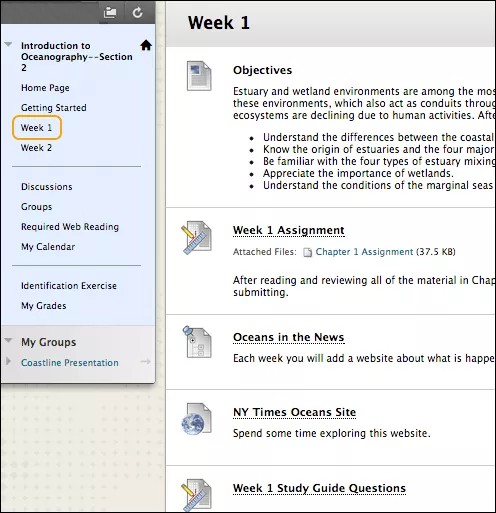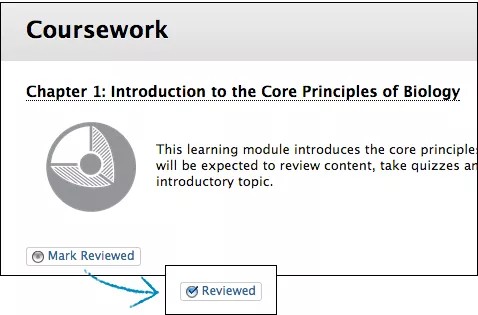How do I access content in my course?
Your instructors can add different types of content to your courses, such as files, text, assignments, images, multimedia, and links. They can organize content in folders, learning modules, and lesson plans.
You access course content from links on the course menu. Links that hold content are called content areas. For example, an instructor may add a content area that contains a week's worth of course material. Week 1 may include content such as readings, assignments, a discussion, and a link to website. Select an item to open it.
Types of content
This table describes the types of content that your instructors can add to courses.
Each item may appear with an icon to denote its content type. Your institution may choose different sets of icons.
If you see a menu with alternative file versions, your institution uses Blackboard Ally to offer alternative download options of your course's content. To learn more, see Ally help for students.
| Icon | Content Type | Description |
|---|---|---|
| Item | An item is a piece of content such as a file, image, or text. Your instructor can include a description and attach files, images, video, and audio. | |
| Assignment | Instructors use assignments to assess your knowledge of course content and objectives. Your instructors often assign grades to assignments. | |
| Survey | Instructors use surveys for polling purposes, evaluations, and to assess your knowledge at that point in time. Surveys aren't graded. | |
| Test | Instructors use tests to assess your knowledge of course content and objectives. Your instructors often assign point values to questions in the test. Your answers are submitted for grading. | |
| File | A file appears as a page within your course or as a separate piece of content in a separate browser window. | |
| Audio | An audio file may play when you open the page and continue to play until you pause it or navigate away from the page. | |
| Image | Images appear on the page. | |
| Video | Videos appear on the page. You have controls to pause, play, and adjust the volume. | |
| Web link | Select the web link to go to a website or resource. | |
| Learning module | A learning module is a content container. You navigate through the content from a table of contents. Your instructor can add all types of content, such as text, images, multimedia, assignments, and tests. | |
| Lesson plan | A lesson plan is a content container. A lesson plan can contain lesson profiles, instructional objectives, and the content items you need to complete a lesson. | |
| Syllabus | A syllabus may contain course information, objectives, grading information, instructor contact information, dates, and textbook information. | |
| Course link | A course link is a shortcut to an item, tool, or area in a course for quick access to relevant materials. | |
| Content folder | A content folder is a content container. Instructors can use folders and sub-folders to group related material, such as a "Week 1 Case Studies" folder inside the "Week 1 Assignments" folder. | |
| Blank page | Instructors can include files, images, and text together on one page. Select the title to view the content. No description appears. | |
| Module page | A module page is a specialized content page that presents content in boxes, such as on a course Home Page or the page you see after you log in. You can keep track of tasks, tests, assignments, and new content created in your course. | |
| Tool | Instructors can add a shortcut to a specific tool in your course, such as the discussion board, blogs, or groups. Or, if the Tools link appears on the course menu, you can access all available tools from the Tools page. | |
| Flickr® Photo | You can view photos and images from their website. | |
| SlideShare Presentation | You can view slide presentations, documents, or Adobe PDF portfolios from other websites. | |
| YouTube™ video | You can view online videos from their website. |
What if I don't see some content?
Instructors can limit which content items you see based on date, time, individual users, course groups, and your performance on graded items.
For example, your instructor restricts access to the next assignment until you complete a test. Your instructor can also require that the assignment doesn't appear until you complete the test and score at least 70 percent.
Ask your instructor about content that you think may not appear for you but should. You might have to meet specific criteria.
When your instructor adds new content in the learning module and you don't see it yet, you can:
- Select the 'Refresh' icon at the top right of the course menu, or
- Log out, log in and try again.
Can I show I've reviewed content?
Review status allows your instructor to track interaction with specific content items. Review status sometimes affects when you can see additional content.
For example, your instructor enables review status for an article. The release of a test is contingent upon your review of the article. After you mark the article reviewed, the test appears.
A Mark Reviewed option appears with items chosen by your instructor. After you review one of the items, select the option to mark it as Reviewed.
You can switch between Reviewed and Mark Reviewed if you want to go back to a content item and review it again. Your instructor only views the current setting. If you mark an item as Reviewed, then switch to Mark Review, your instructor doesn't see that the item was marked Reviewed at any time.
Ally in Learn Original - Studente
Visualizzare i formati alternativi dei file
Non hai familiarità con l’argomento? Vai all’articolo della Guida “Ultra” su come visualizzare i formati alternativi dei file.
Il tuo istituto controlla quali strumenti sono disponibili.
Ogni studente ha capacità di apprendimento e preferenze uniche. Se un docente offre agli studenti contenuti più accessibili, sta dando a ognuno di essi la possibilità di scegliere il formato più adatto alle proprie esigenze. Se il tuo istituto utilizza Blackboard Ally, i docenti possono usare questo strumento per garantire che i contenuti dei corsi siano accessibili per ogni studente.
Dopo che il docente ha allegato i file a un corso, Ally crea i formati alternativi di quei file basandosi sugli originali. Ad esempio, se il file originale è un PDF, Ally crea formati audio, braille elettronico ed ePub dello stesso contenuto. Questi formati sono disponibili insieme al file originale, in modo che ogni cosa si trovi in un’unica, comoda posizione.
I formati alternativi creati dipendono dal tipo di file originale. Se l’opzione per scaricare i formati alternativi non è disponibile, significa che Ally non è abilitato per quel corso o che il file non è un tipo di contenuto supportato.
Trova un file nel corso. Apri il menu accanto al file, quindi seleziona Formati alternativi. Scegli la versione più adatta alle tue esigenze. Seleziona Scarica per salvare il formato alternativo sul dispositivo che utilizzi.
Ulteriori informazioni sui formati alternativi dei contenuti dei corsi


















